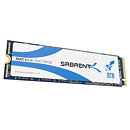Thursday, May 21st 2020
Sabrent Launches World's First 8 Terabyte M.2 NVMe SSD
Sabrent, a company focused on making storage devices and PC accessories, today announced the release of the world's first 8 terabyte NVMe SSD delivered in the M.2 form factor. The new SSD dubbed Rocket Q 8 TB NVMe PCIe M.2 SSD is a real treat for all SSD enthusiasts. Besides its staggering capacity, it has plenty of features as well. Built on top of 3D QLC NAND Flash memory chips, the Rocket Q SSD is supposed to deliver very high speeds on PCIe 3.0 x4 bus. With up to 3.4 GB/sec reads, and up to 3 GB/sec writes, the SSD is pushing the limits of the PCIe 3.0 x4 bus that it is designed to work for.
Rocking a Phison's E12S controller, it is supposed to maintain high speeds even on random 4K reads and writes. The company didn't reveal too many details about the performance, however, we can wait for some reviews. The SSD is PCIe 3.1 Compliant, NVMe 1.3 Compliant, and supports SMART and TRIM commands. With a purchase of this SSD, you get a free copy of Sabrent Acronis True Image for Sabrent Software for easy cloning. Pricing and availability are unknown.
Source:
TweakTown
Rocking a Phison's E12S controller, it is supposed to maintain high speeds even on random 4K reads and writes. The company didn't reveal too many details about the performance, however, we can wait for some reviews. The SSD is PCIe 3.1 Compliant, NVMe 1.3 Compliant, and supports SMART and TRIM commands. With a purchase of this SSD, you get a free copy of Sabrent Acronis True Image for Sabrent Software for easy cloning. Pricing and availability are unknown.


36 Comments on Sabrent Launches World's First 8 Terabyte M.2 NVMe SSD
QLC in this one is probably not a price question but a density one and the price of this drive will be north of $1500.
Edit:
4TB Rocket Q is $759. 8TB will be twice that and probably a bit more.
Now just work on the pricing, Sabrent.
Prices of these at $900 and $760 are closer than I'd like to see.
www.sabrent.com/product/SB-ROCKET-4TB/4tb-rocket-nvme-pcie-m-2-2280-internal-ssd-high-performance-solid-state-drive/
www.sabrent.com/product/SB-RKTQ-4TB/rocket-q-4tb-nvme-pcie-m-2-2280-internal-ssd-high-performance-solid-state-drive/
www.canadacomputers.com/product_info.php?cPath=179_1927_1930&item_id=135646
www.canadacomputers.com/product_info.php?cPath=179_1927_1930&item_id=133813
Adata 1 TB $219 Cad vs Samsung 970 Evo 1 TB $349.99 on sale.
But the 500GB is 189.99 so pay $30 more for another 500GB
www.canadacomputers.com/product_info.php?cPath=179_1927_1930&item_id=135645